Photo
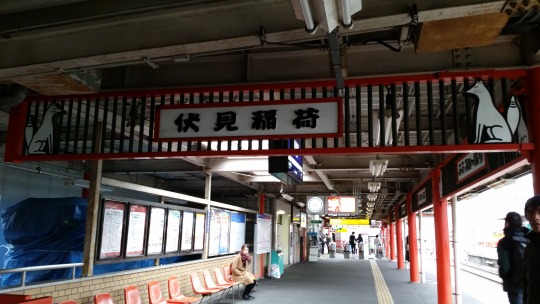
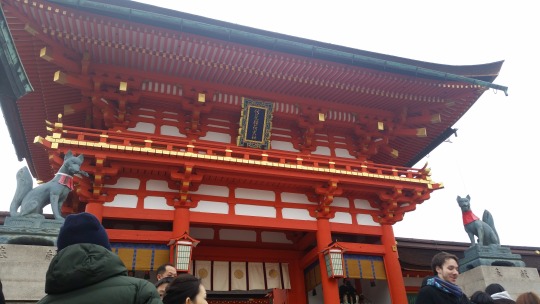
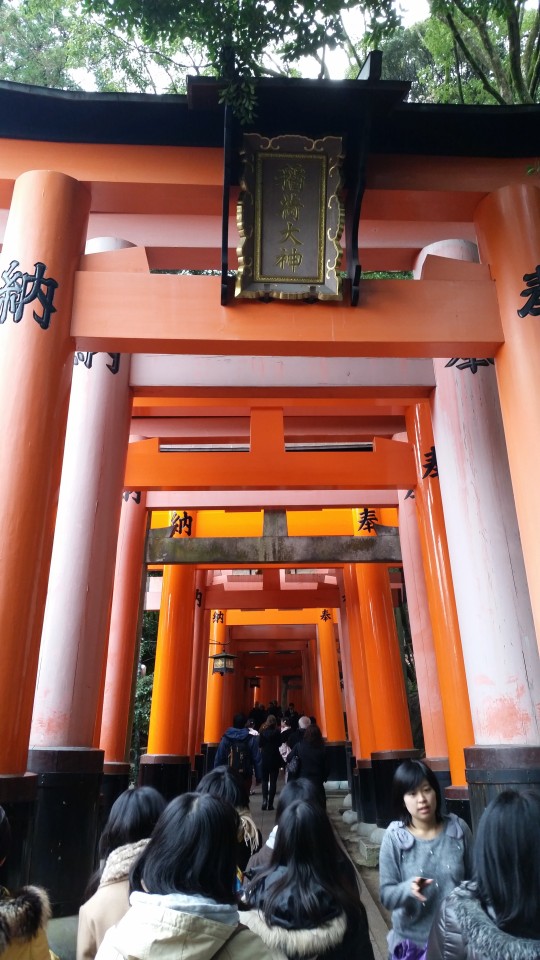

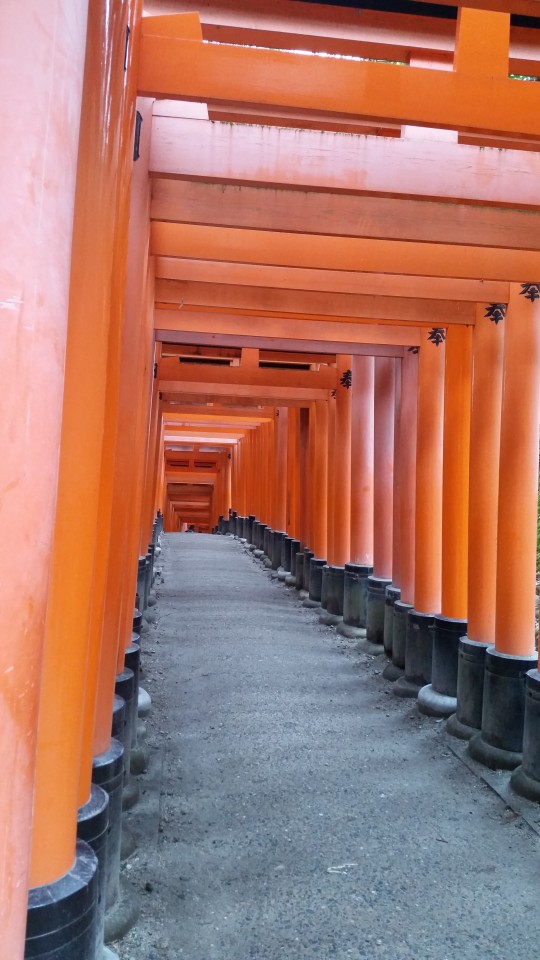

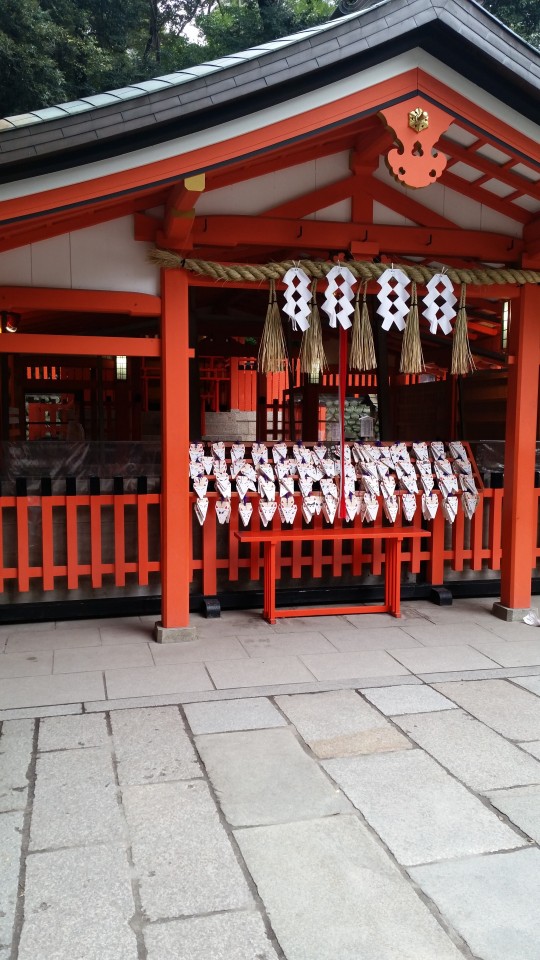

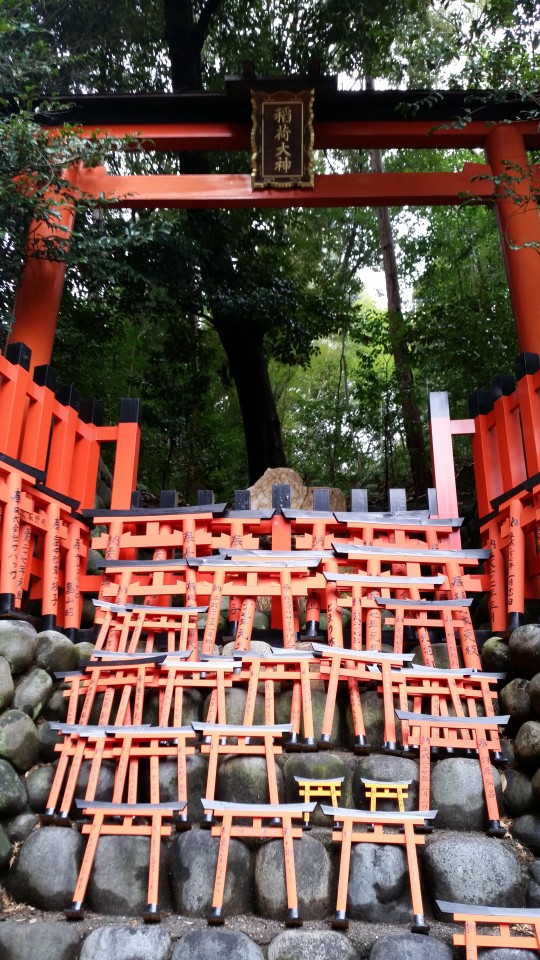

Fushimi Inari Shrine in Kyoto. It’s famous for the one thousand torii (the vermillion gates). For the first leg, the torii are lined right next to each other, but if you choose to hike up the mountain, they apparently get further spaced out. It takes a couple of hours to go up and down the full thing, so we only went up the first portion for the view of the torii. Going up is meant more for reflection and strolling along nature rather than for praying at the shrine itself, although there are dozens of miniature shrines on the path you can pray at if you prefer to pray in seclusion than pray at the main building.
This was when I was on the road trip with the same group that went up to Sapporo. We traveled to Ise Jingu, Kyoto, Hiroshima, and then made a stop in Kobe on the way back to Tokyo. It was three days, two nights (three counting the drive back home).
I have many more pictures of this shrine when I came here with a friend on our one week trip.
2 notes
·
View notes
Photo

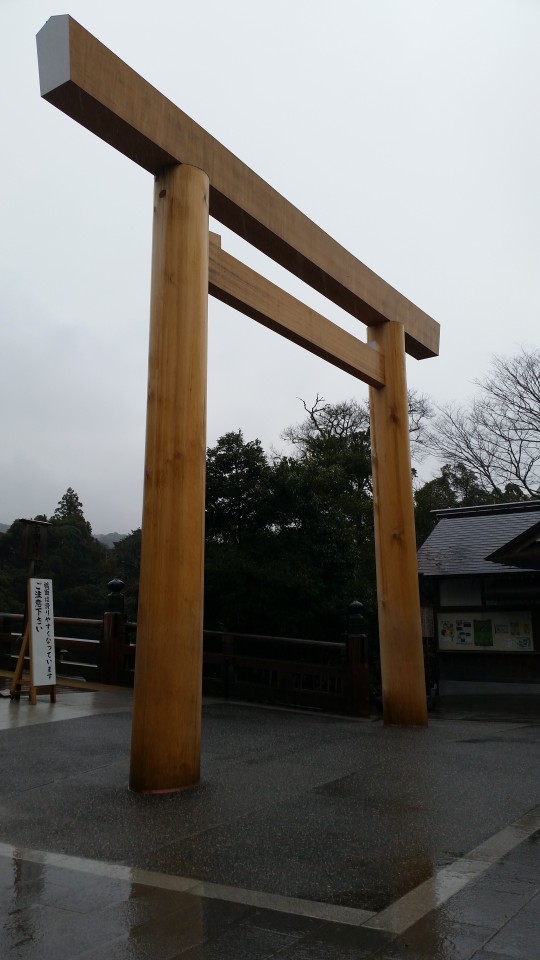
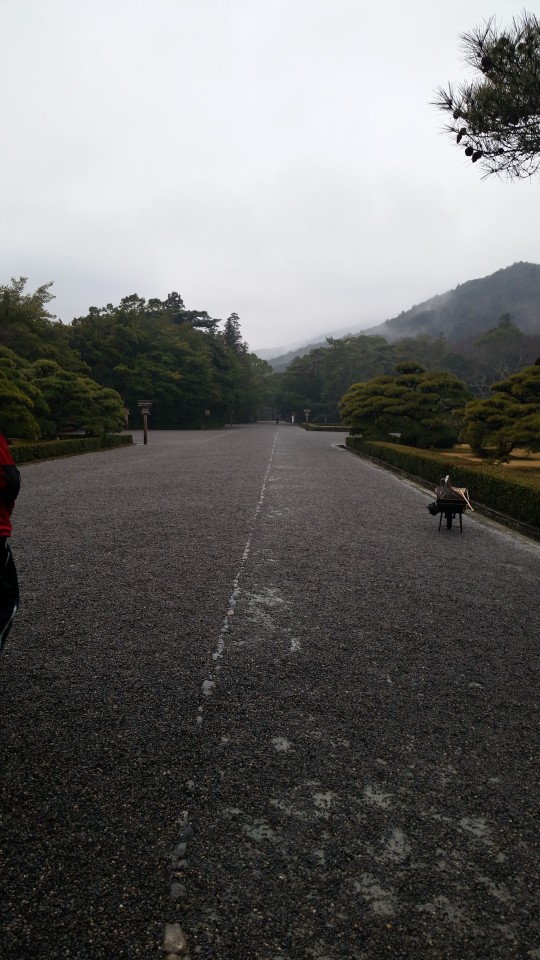
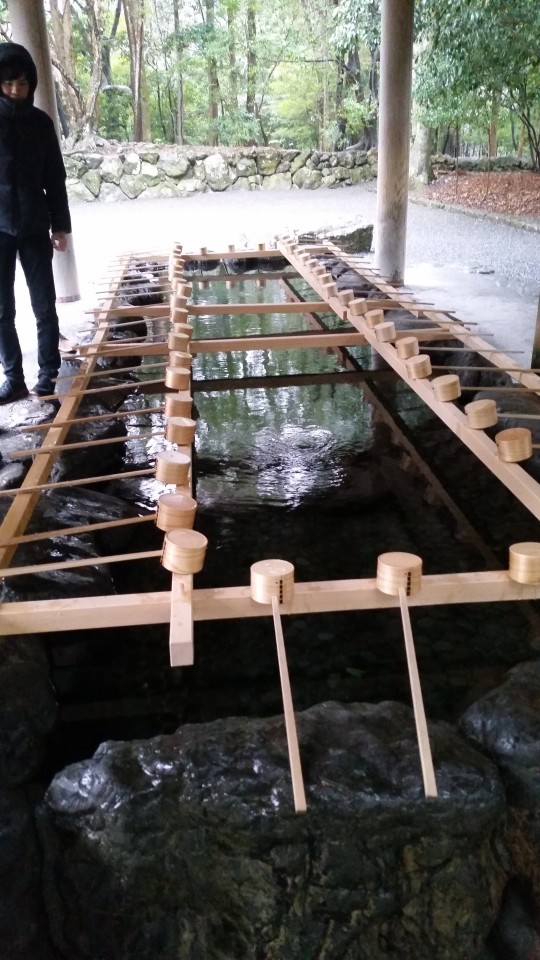


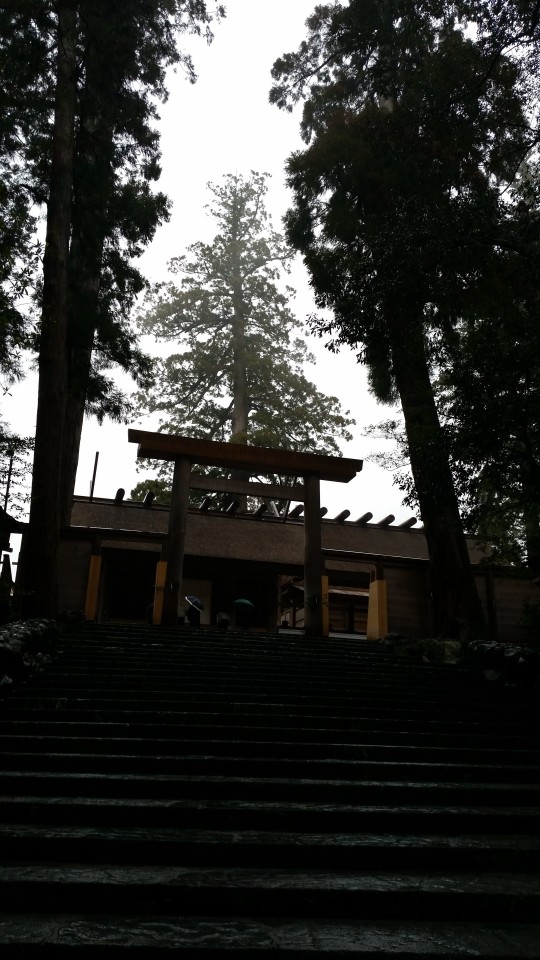
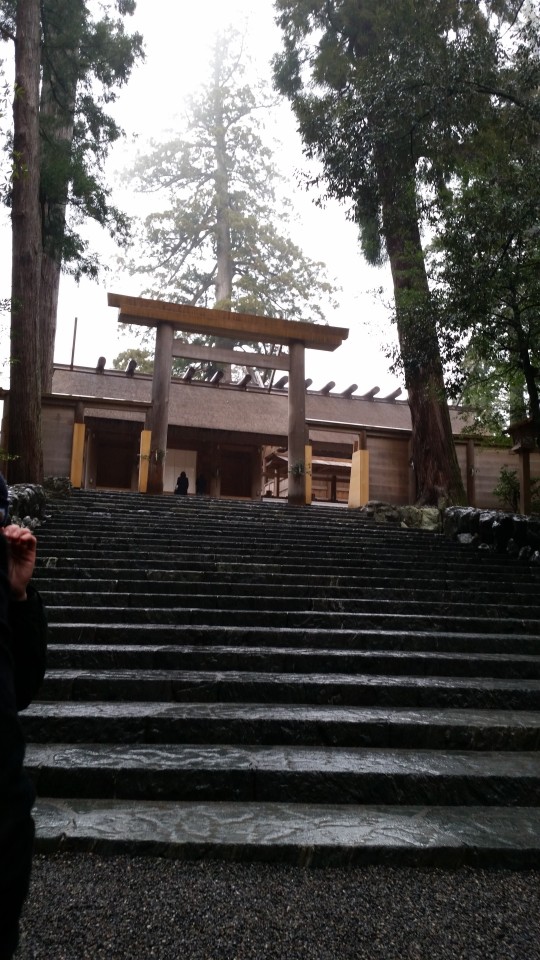


Ise Jingu (Ise Grand Shrine) - the main shrine dedicated to the Sun Goddess Amaterasu. She’s basically the top of all the deities in the Shinto religion. You could call her a triplet with her brothers Tsukiyomi (God of the moon) and Susano’o (a trickster, but originally supposed to be in charge of the sea), but she is pretty much the uncontested most important deity in the religion. There are many other important gods, but she’s the “leader” so to speak. The river that flows by it is also considered sacred. You can wash your hands there to cleanse yourself (of bad influence/luck, evil, that sort of thing).
Besides Ise, the other shrine that holds an equal level of importance is Izumo Taisha. The legend goes that Amaterasu wanted Japan and asked Ookuni Nushi (who was watching/lording over it) to grant it to her. He did so on the agreement that the people of the land would continue to pay respect to him at Izumo Taisha. It is said that for one month of the year, all the gods go to Izumo Taisha for a conference. The people around the region still regularly follow the old traditions as well.
82 notes
·
View notes
Text
Revived
First off, I want to apologize for the hiatus.
Leave it to GACKT for coming at the right moment to kick me back into gear. His DVD/CD set of the Winter concert I went to arrived a couple of days ago and I had the chance to watch/listen to them yesterday and today. Once again, he’s giving me a push on the back as he always strives to do with his songs and actions.
I think one of the main reasons why it’s hard for me to post consistently, is that I’m treating them in my head as articles, when they’re not exactly supposed to be. I might shift this to a “Throwback Thursday, Flashback Friday” format and post pictures randomly instead of trying to parse them down to “the ones I can’t leave out.” This will also solve the problem of when I don’t have interesting photos mid-semester due to not going out to new places. You might notice the background I changed. That’s just one of many, many photos I took at the hanami I went to this past season. So look forward to that as well as pictures from Hiroshima/Osaka/Kyoto/Nara with my friend, and Yokohama/Tokyo when I went sightseeing with my mom.
Now that the Spring Semester is starting, and my club activities are picking up and forming new bonds, I’ll have more stories, too. I’m doing well with my “boyfriend” too -- my lovely 藤 (Fuji) and I spend many a night serenading the other residents with half-learned songs and fumbling fingers.
As for now, I’m going to a koto concert tomorrow morning with a couple of other club members, so I need to finish paperwork and then coordinate stuff with them before I head to my art club. Things are just starting here in Japan, but Finals are in progress back at my home university in the U.S. so it feels like I’m coordinating two lives at once. It’s a strange feeling -- like there are two timelines going on at once.
よっしゃ!(All right!) Running full speed, here I go. 行ってきます~
1 note
·
View note
Text
Start of Tokyo Travels
I'll get to writing about my last trip soon (there's lots of stuff I learned and info/advice to give), but first, a simple post to mark this day...
It's been one trip after the other giving a nonstop, rushing kind of feeling. Parts of Hokkaido, then a Ise/Kyoto/Hiroshima trip, followed by a week-long Hiroshima/Osaka/Nara/Kyoto trip, and now a week-long tour around Tokyo.
But... this last one is special. My mom has come all the way across the ocean to spend time with me for a week. She had always wanted to visit Europe, but I hope she will come to like Japan, too.
I have the privilege of introducing Japan to her in this first visit of hers.
When I mentioned my mom not understanding any Japanese, my koto Sensei said: "Ganbatte!" because I'll need to explain everything. I could only laugh because that's true. However, it'll be fine. The point is spending time with a family member I haven't seen in a while. A family member who's crossed an entire ocean to see me.
Here we go -- one week of showing Tokyo to my mom!
0 notes
Text
Second trip around Japan: Ise/Kyoto/Hiroshima
I'm leaving for the last trip of this month in about four hours and I still have to finish writing down all the hotel/hostel info and bus numbers, so I'll write as much as I can about my previous trip before I need to hurry. All those post that went up to finish Sapporo? That was while I was on my trip. I have a lot of catching up to do.
I was gone on a trip to Kyoto and Hiroshima with the same club that went up to Sapporo. We made it a road trip and it took about 7 hours by car to Kyoto travelling through the night. Ugh, cars... We took a huge 10-person car that was more like a bus. Normally I can sleep fairly easily in any car and this helps with dealing with my car-specific motion sickness, but this time I had such a tumultuous experience waking up every 20 minutes or staying in that trance/meditation-like state where you're not quite asleep, but just resting... I kept turning to get into a new, hopefully more comfortable, position while trying to not wake up the guy sitting next to me. My body just felt like goo with a couple of creaky sticks giving me pain and a water balloon acting as a stomach... well, the phrase "kibun ga warui" comes to mind. Simply, "my body feels bad."
Well, eventually those hours passed, we arrived at Ise Jingu (Ise Shrine), and then we were off!
It was cool wandering the streets at 7 a.m. before anyone was around. All the shops were closed save for a couple like Family Mart and a little shop we ended up eating breakfast at. It was what in the past would have been a coffee shop -- a place to meet, sit, drink tea with a pastry, and chat. The shop is apparently pretty famous for the azuki mochi. The layout of the shop was also nice -- you can see the workers preparing the red-bean paste in the front of the shop and you pass them to get to the seating area. There are only very thin "walls" separating the shop from the outside. They were paper screen doors with windows to see the river that flows behind the shop, and being winter, they didn't do much to protect from the cold. Everyone sat on the tatami huddled around the braziers and the hot tea served with the mochi was a welcome sight.
After eating, we went to Ise Shrine itself. Ise is one of the two most important shrines to the Japanese. Along with Izumo, Ise is the origin of Japan. There's a lot of folklore about the two shrines that I don't have time to get into, but one I love about Ise is the story of Amaterasu -- the sun goddess and pretty much the top, top kami (god/dess) in Shintoism. Her brother, Susano'o, pulled a mean prank and scared one of Amaterasu's handmaids. Fed up with him (he's the lazy, trickster god who causes much mischief), she fled the heavens to a cave at Ise where she sealed herself away -- thus creating the first solar eclipse. The others gods and goddesses came up with a plan to lure her out. They decided to have a grand party outside the cave so Amaterasu would be curious and want to join the fun. When she peaked out from behind the boulder obstructing the cave entrance, one of the gods reflected her image back to her with a mirror -- stunning her with the realization of the sad face she had on. Another god then pulled her out. The sun returned, everyone continued partying, and life went on.
At any rate, Ise is important.
I'll talk more about specific places around the shine grounds when I post up pictures, so for now I'm moving on.
We went to Kyoto and saw a couple of famous places. After lunch in the Gion district, we went to Fushimi Inari -- it's one of those popular sights on tourist brochures of Japan. The thousand torii (red gates) lined up to make almost a tunnel. It's a gorgeous shrine with many smaller shrines scattered throughout the grounds.
We then went to Kinkakuji (The Golden Pavilion) and it's really pretty in person. We went in the late afternoon before it closed -- around 4:30 -- and the clouds were luckily parting, allowing us to see the setting sun gently bounce off the gold-covered second and third floors.
I'll be going to Ginkakuji (The Silver Pavilion) as well with my friend when we're in Kyoto, so I'm pretty excited for the chance to see both. Actually, I prefer silver to gold and when I planned a trip around Kyoto for a Japanese class back in high school, I included Ginkakuji and not Kinkakuji... Kinkaku gets so much hype, but actually, everyone knows Ginkaku has the better gardens...
But yes...
After Kyoto we went to Hiroshima...
I'd like to make a long and worthy post, but I'm running out of time... I'll write it on my phone while we're on the bus there and try to post it at some point. We did a lot there. Seeing the A-dome, going around the peace memorial park, visiting the museum... going to a marine wartime technology museum and Itsukushima (the torii that's floating on the water and which is seen in many tourist brochures), cycling...
We stopped by Kobe on our way back to Tokyo and went up a steep mountain at night to get to a sightseeing spot (apparently popular with couples) from which we could see all of Kobe and Osaka. It was breathtaking -- like a starry night spreading out below us in the inky darkness.
It was a long trip back home from there and I arrived back to my dorm at a little after 5 A.M.
And six days later I'm going all the way back to Hiroshima. Here we go!
0 notes
Photo
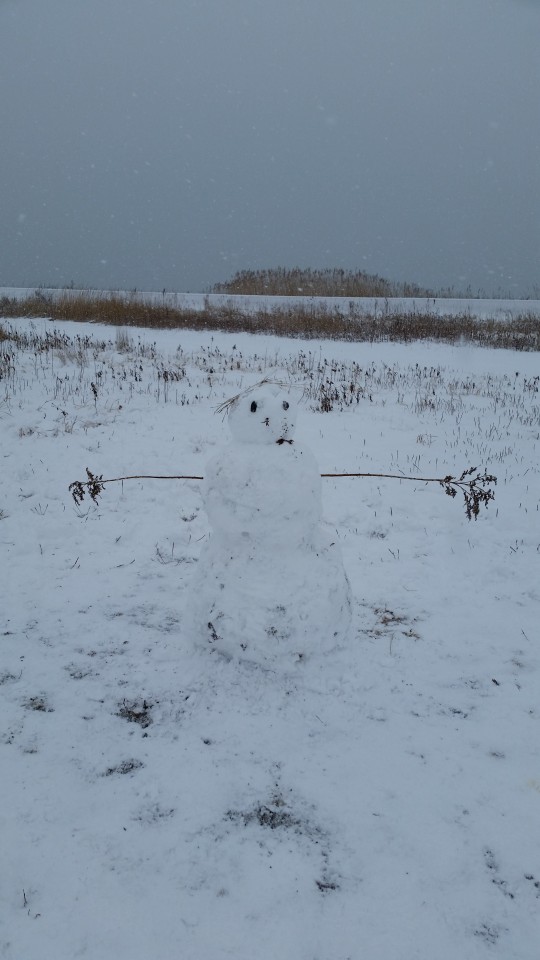
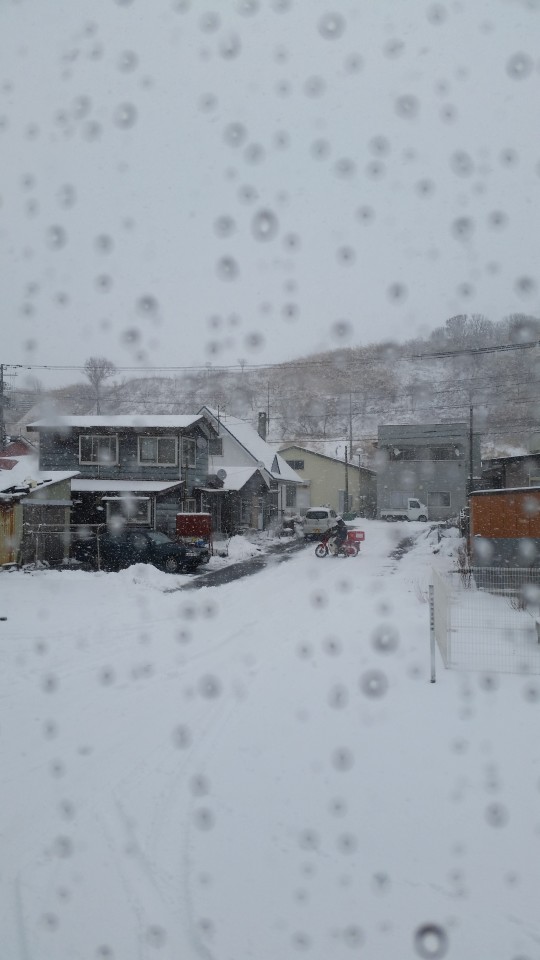
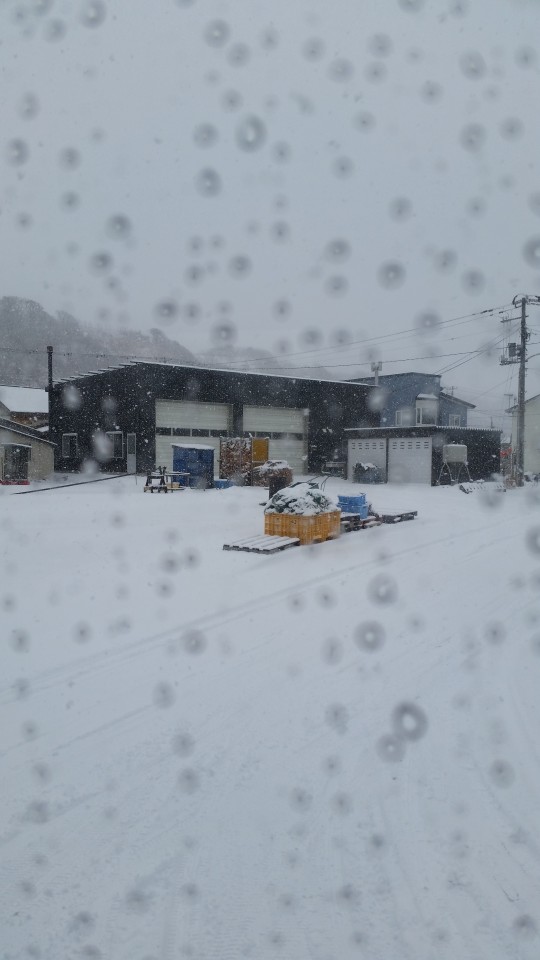
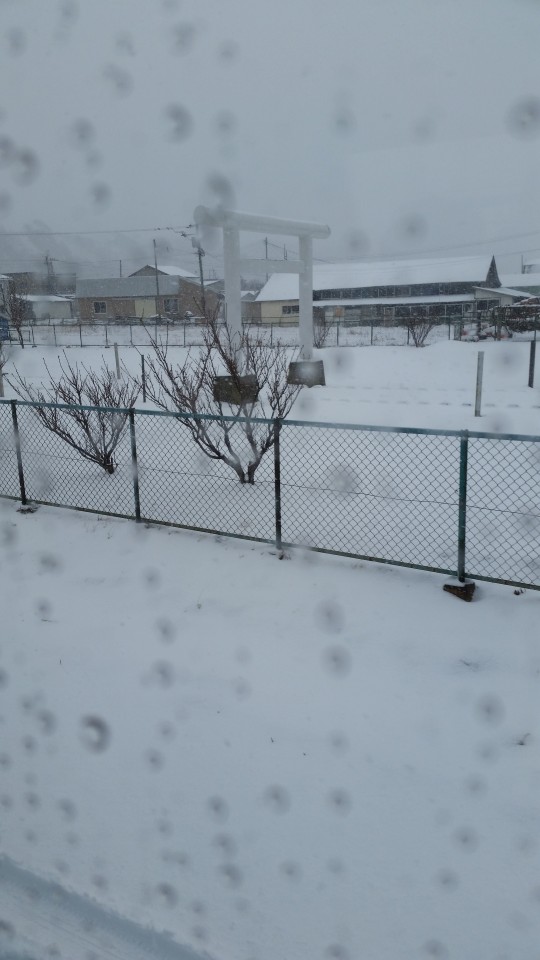
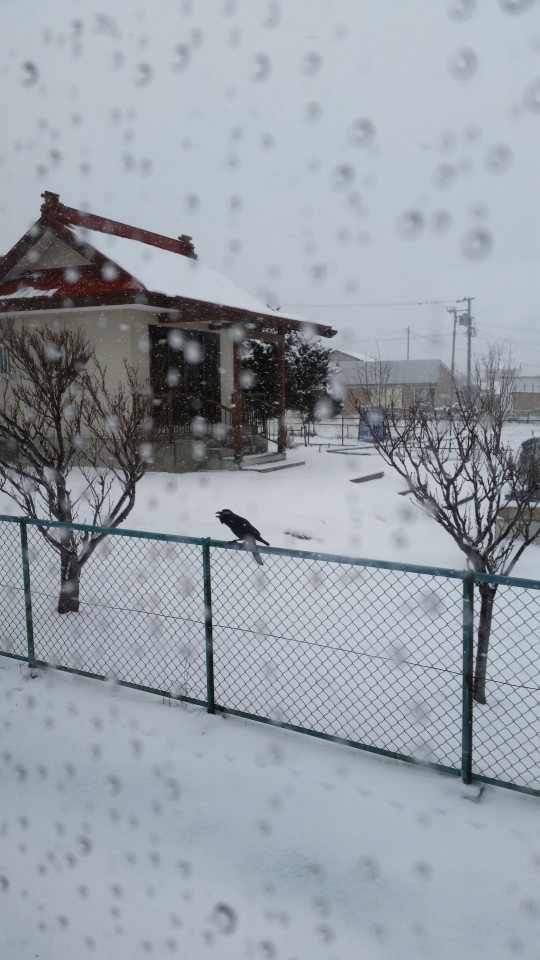

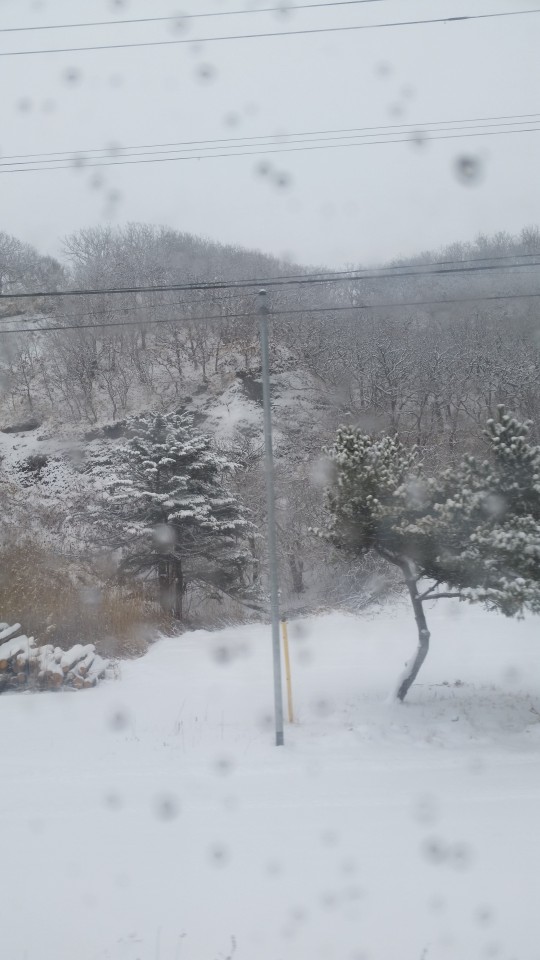
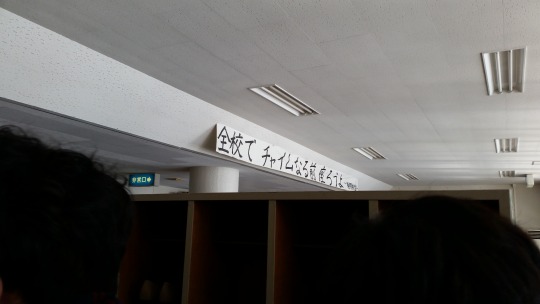
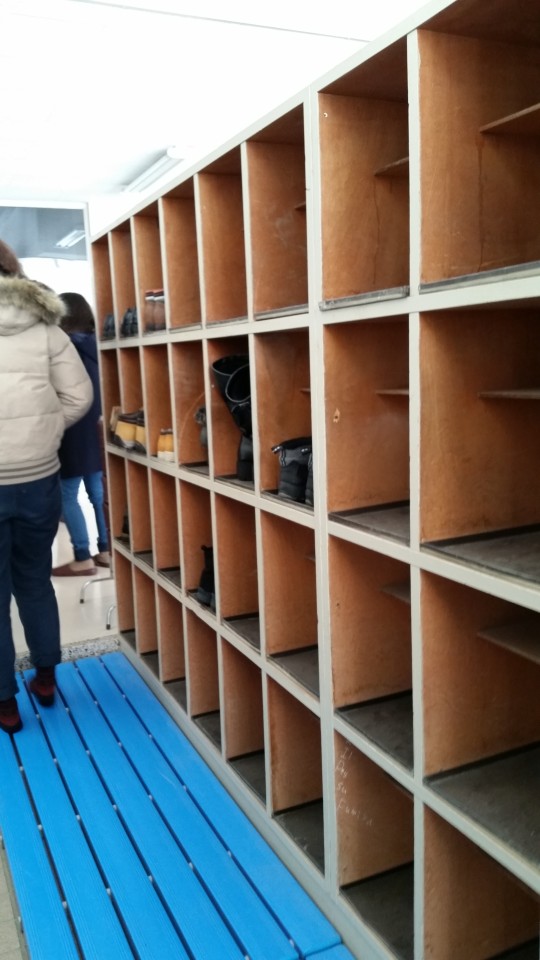
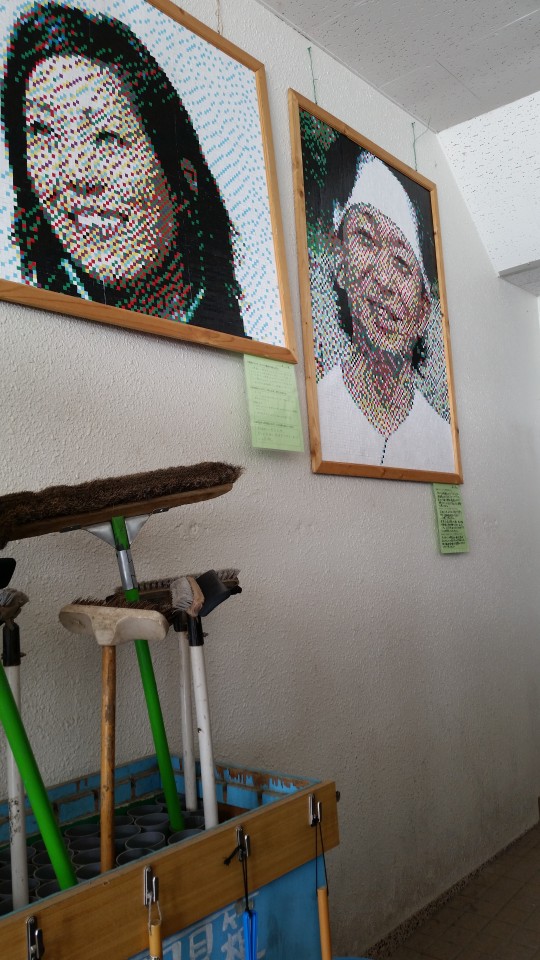
Hokkaido Day 3 Part 4: Playing in the snow and visiting Tomikawa Junior High
My first snowman: Tomio-chan. As someone was rolling a huge ball for the base, I jumped in and made the middle and head. Look how wide the arms are -- like she wants to give you a great bug hug! The name was thought of by someone else in following the name of the junior high we would visit right afterward -- Tomikawa.
Somewhere between arriving to eat lunch with the elders, and putting away our outside shoes in Tomikawa Junior High, I lost my glasses (I had them in a pocket). It was probably with Tomio-chan or when making snowballs...
The last three pictures are of the entrance of Tomikawa Junior High. I want to make a more detailed post later on the games we played (karuta and making origami) and the questions asked by the third year class. That'll have to wait until later, though.
0 notes
Photo
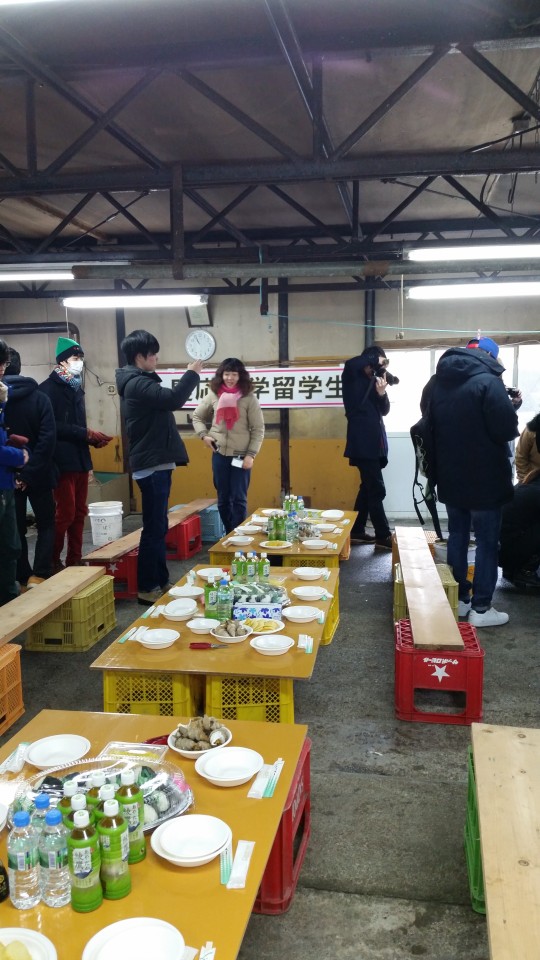

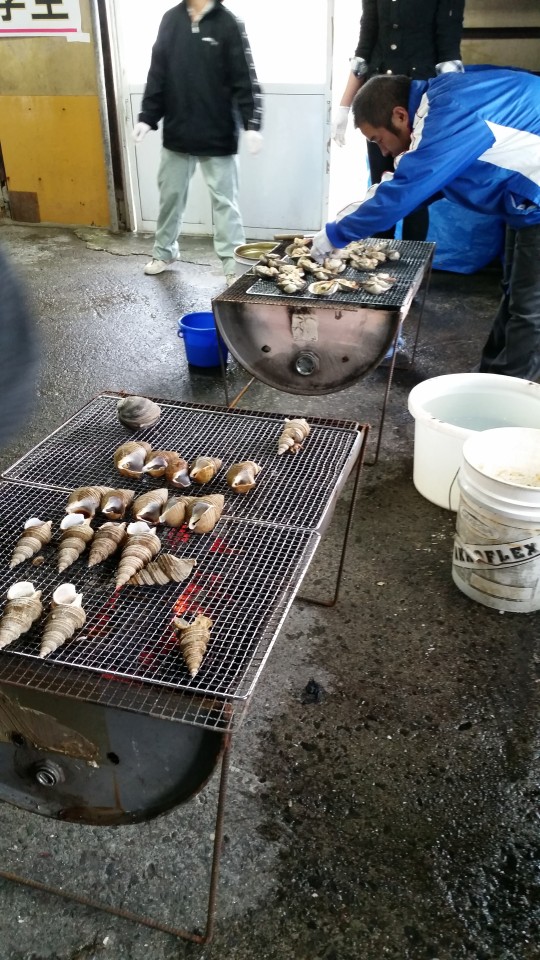
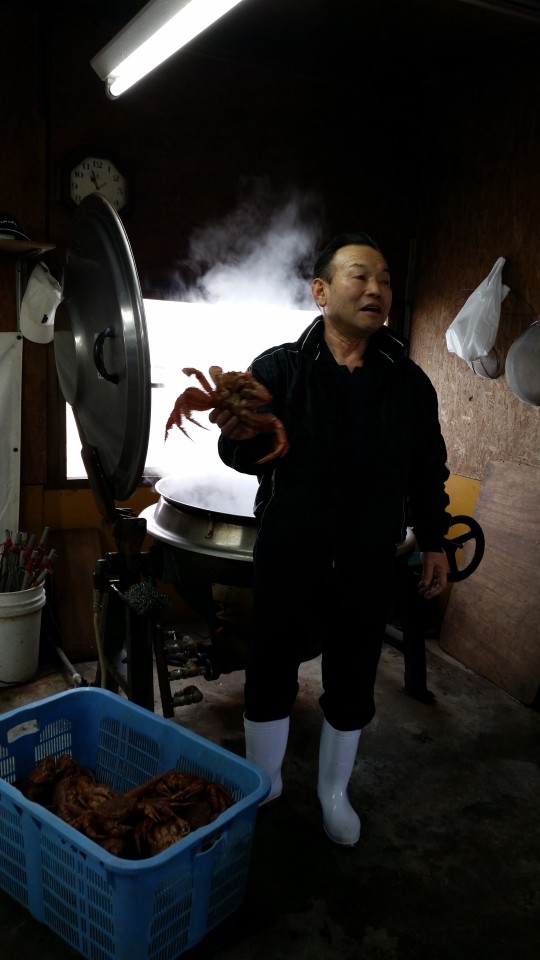

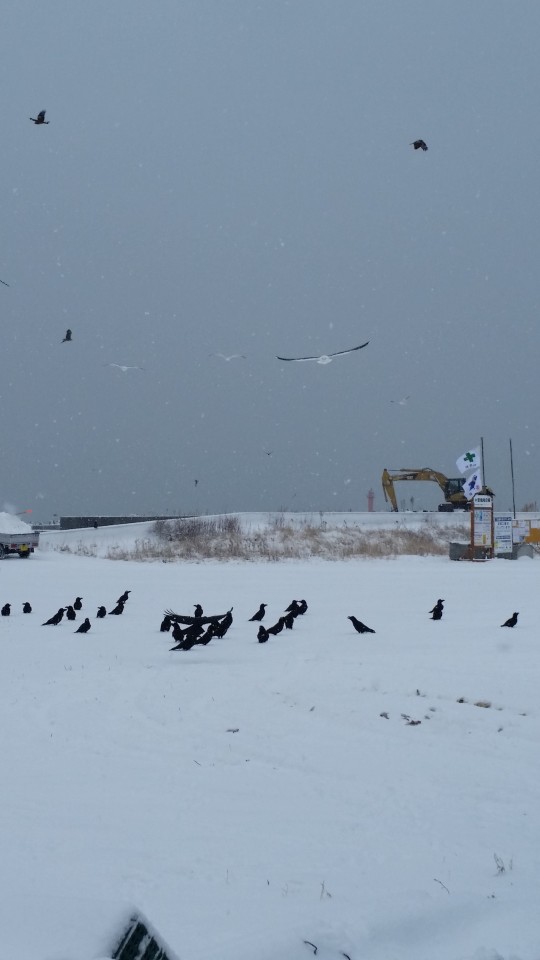
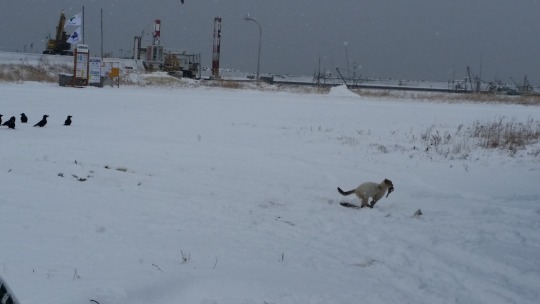



Hokkaido Day 3 Part 3: Lunch with the locals near Ishisaki Fisheries.
The guy who cooked the crab here is also the same guy who did the demonstration to the kids (the day before at the cooking lesson) of how a full cod is cut up into different pieces to eat. He's apparently 73 years old.
This was first time actually eating these types of seafood for me.
Eating crab was particularly interesting -- it was the first time eating a whole crab for nearly everyone. The old ladies helped us with that. First you tear the body/head in half with your hands and eat the stuff in the head. Eating crab brain was interesting. It tasted like sea water and eggs.
Then pick around the main body to push the flesh out. You use the head as your plate as you do this. Finally, you move on to the legs -- what most people are used to -- and pick out the flesh there. Gruesome? Messy? A bit.
There was also onigiri and takuon (pickled daikon) along with the seafood.
There are a few cats on the premises. It didn't come through the door even with the prompting of the owners, but we saw it looking in multiple times.
0 notes
Photo
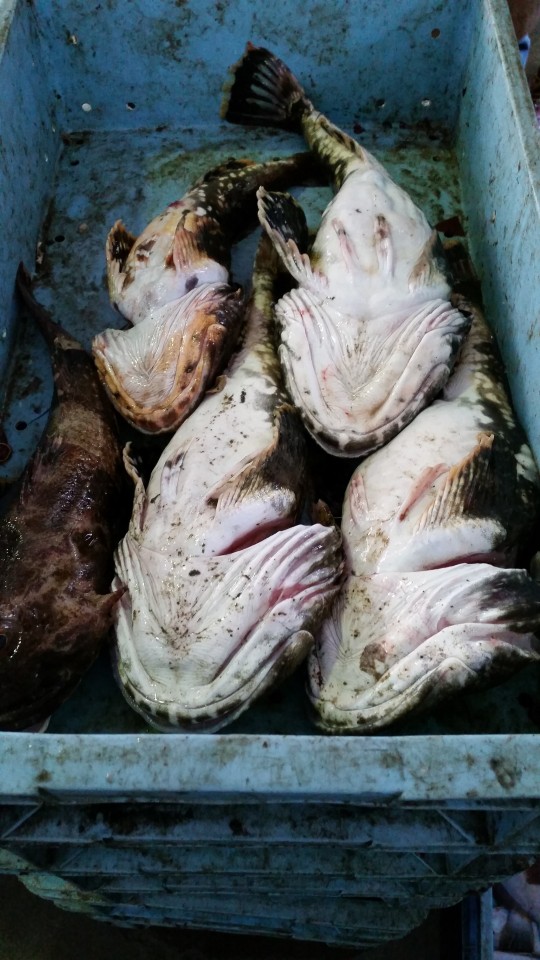
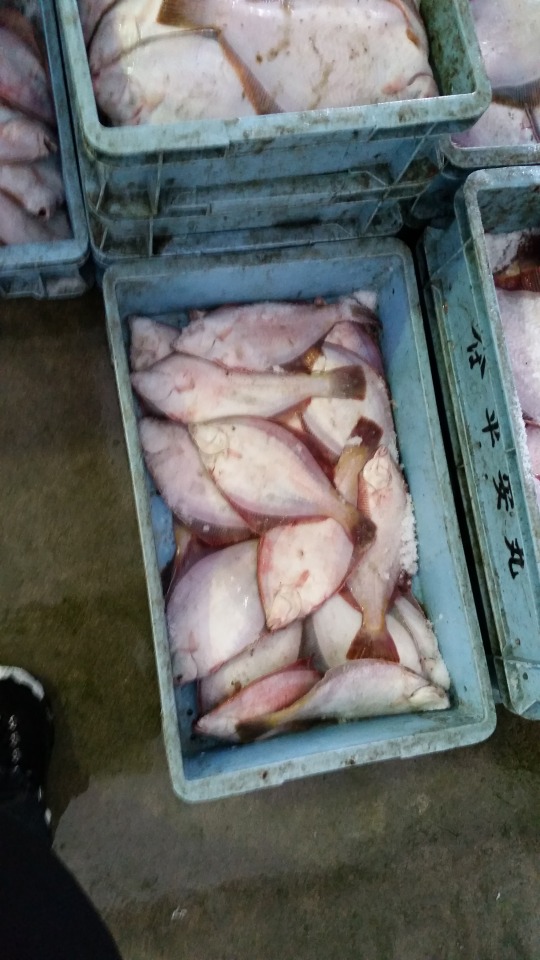

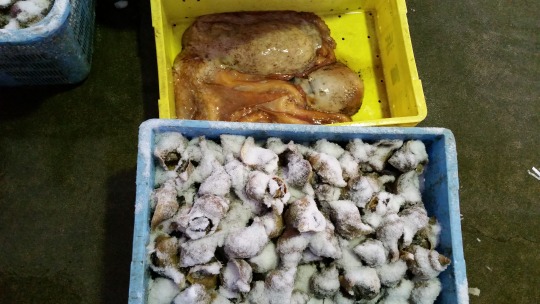
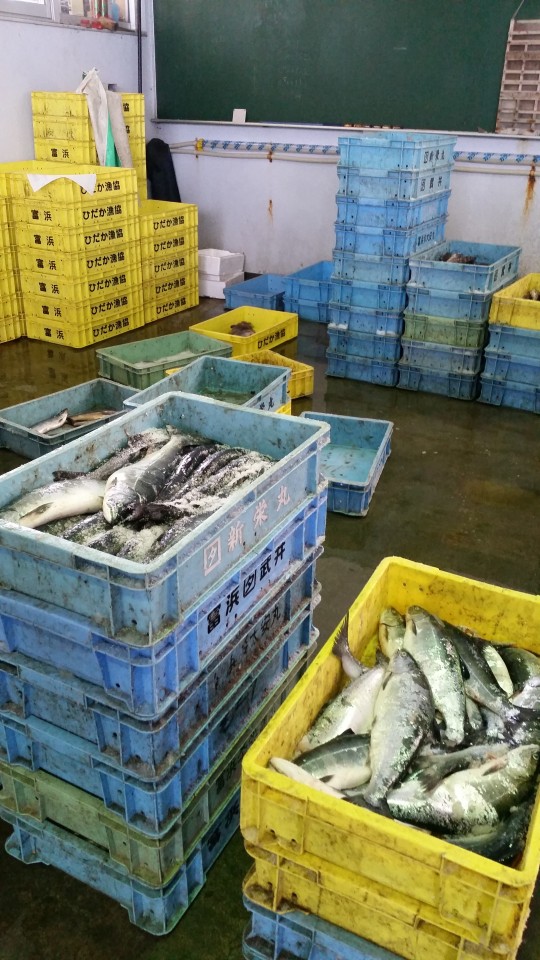


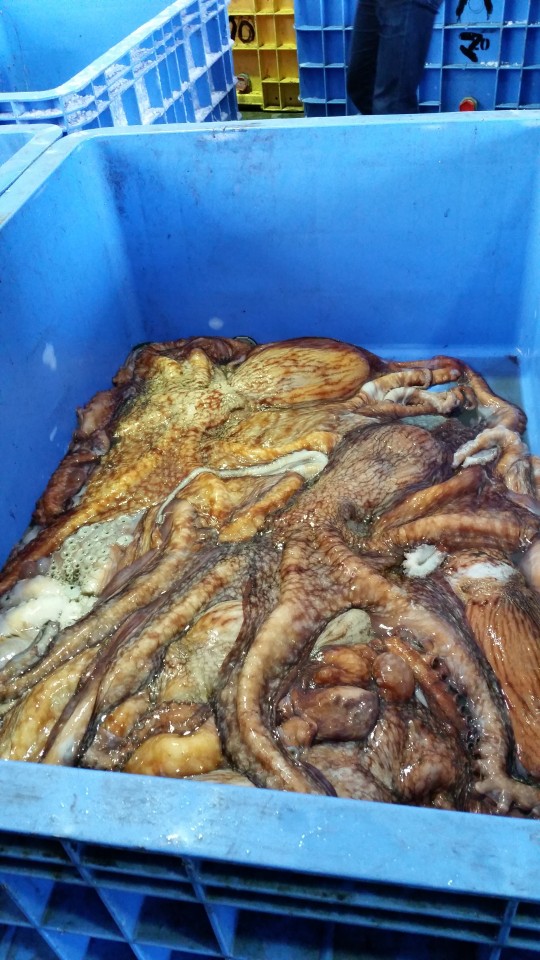


Hokkaido Day 3 Part 2: At Hidaka prefecture fisheries. Specifically, Atsuga Fishing Port and then Ishisaki Fisheries.
We actually were supposed to see the loading docks and then go on a fishing boat for a ride around the area, but it was cancelled due to the weather.
By the way, that huge octopus that greeted us when we walked into the second fishing port is approximately 40 or so kilograms (around 90 pounds)-- as estimated by one of the workers there.
"This is what I would look like at a murder scene if I had no bones. 100 pounds of jelly." That strange thought crossed my mind.
0 notes
Photo
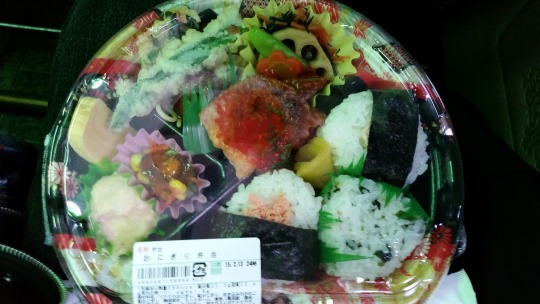




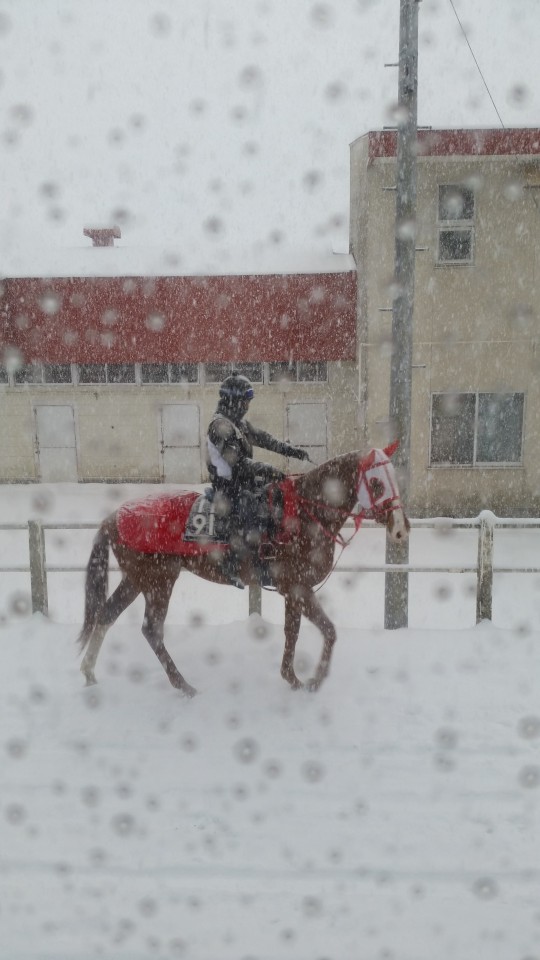
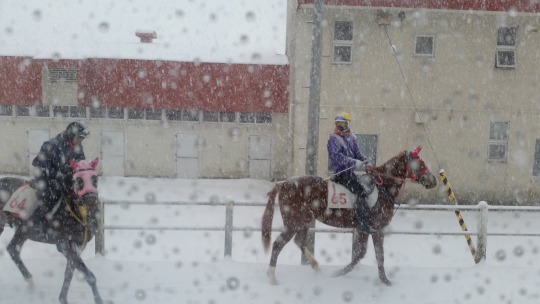

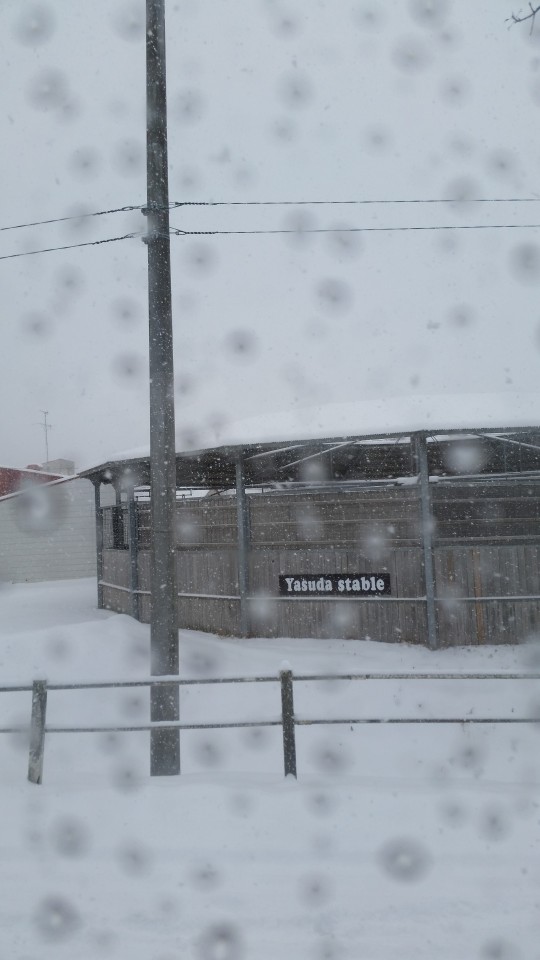
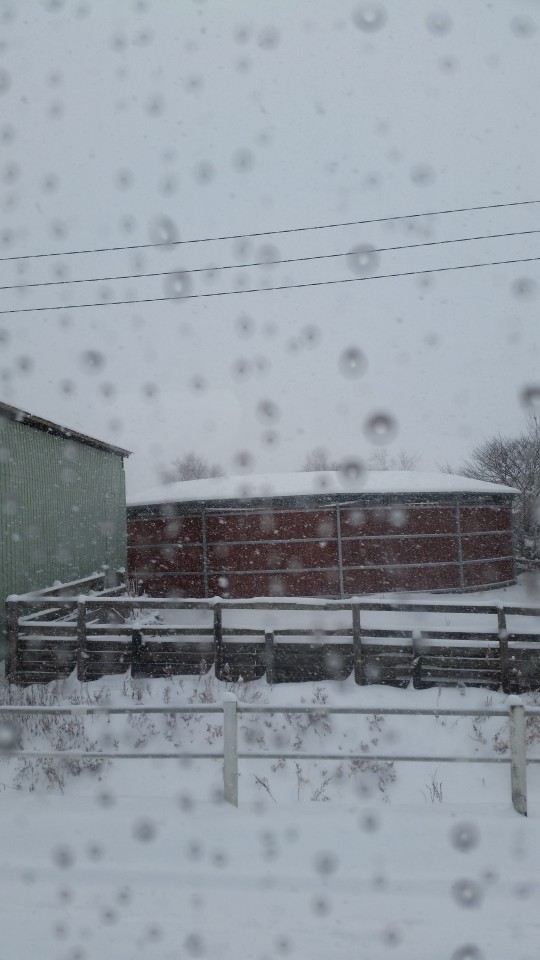
Hokkaido Day 3 Part 1: Mombetsu Racecourse
We woke up at 6 A.M. to clean/put in order the rooms of the hostel we stayed in, and ate breakfast on the bus ride to Mombetsu Racecourse.
It was super snowy! I finally got to see the fluffy snow I wanted. We first saw the horses and riders practicing in an indoor course and then went out to the racetrack with stands. We passed a few riders on the bus ride across the facility. Because it was snowy, we couldn't see the full racecourse -- just what was in front of us.
0 notes
Photo

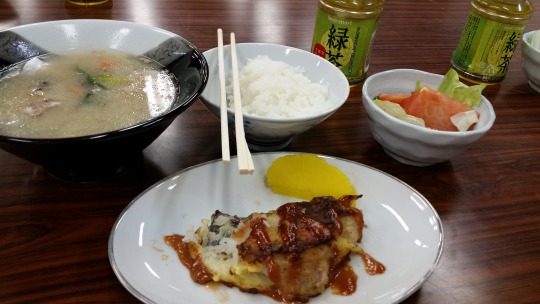

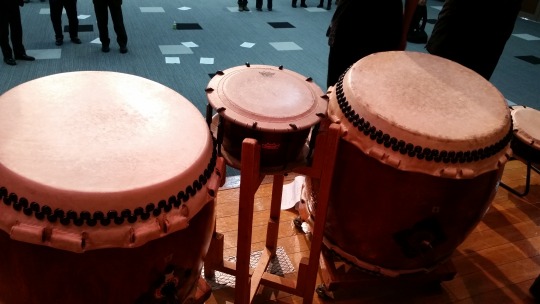
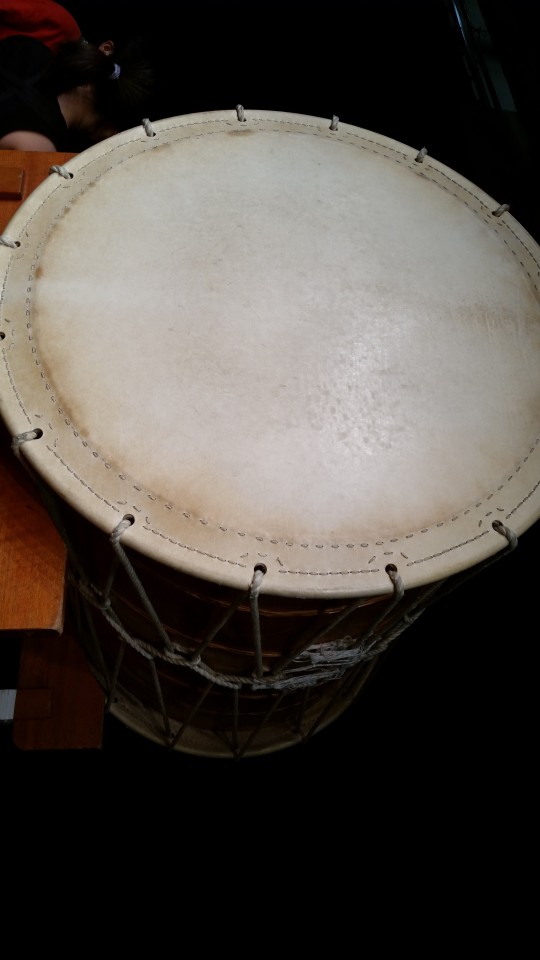

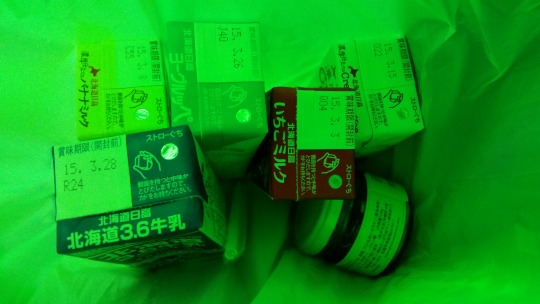
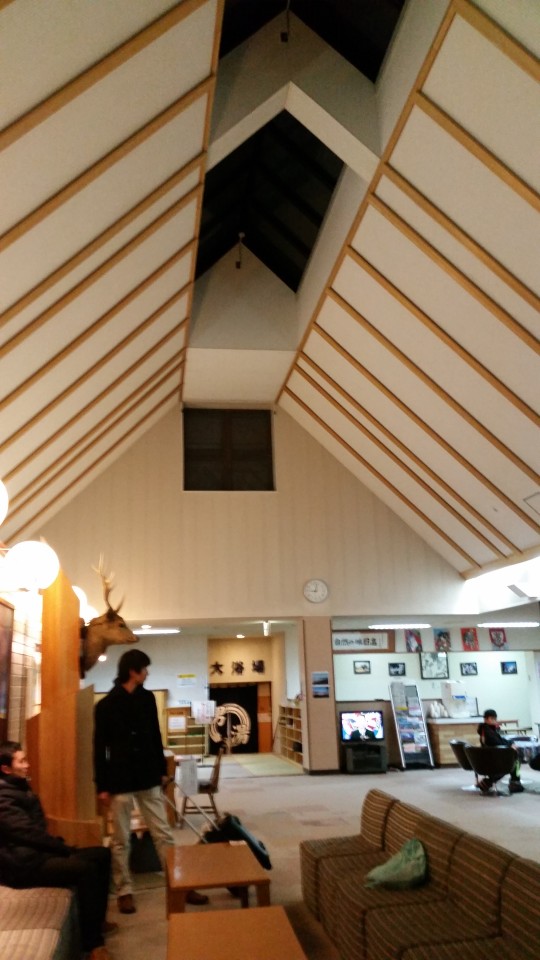
Creating the meal, and the finished product (after taking a couple of bites -- sorry!). The taiko performance was really cool. Most of the performers were women, actually. I thought it was rude to take pictures, so I only took this one at the beginning before the women popped out from behind the drums and the action really started. After the full performance of four songs was done, they let us get on stage and I took closer pictures of the instruments.
Before we went to the National Hidaka Youth Outdoor Learning Center (our accommodations), we used their ofuro (spa/bath) next door. It's an onsen (hot spring), but just a small spring so that it's one bathing pool for each side.
As for why that one picture is green, it's because I took the picture on the bus which, for some reason, had only green and pink lights -- it was green that night. These were the milk drinks that were given as souvenirs after the cooking class. Hokkaido milk is the best milk in Japan. You could compare it to how Wisconsin is known for good cheese in the U.S. Regular milk, ichigo (strawberry) milk, cream coffee, banana milk, and Yoghurppe (a yogurt milk).
1 note
·
View note
Text
Hokkaido Day 2 Part 2: Cooking in Hidaka and Lodging
From Lake Shikotsu we went to Hidaka where we participated in a cooking class with elementary kids at the Hidaka Town center. It started with two officials unfurling a banner saying "Welcome Keio Students" and walking in to be greeted by TV cameras. NHK Hokkaido would be using footage for a program the following night. NHK is a national television broadcasting company in Japan with NHK Hokkaido being a local branch.
The children arrived soon after and some of us were surprised -- no one told us "cooking with locals" meant we would be cooking alongside local elementary students. I thought it meant local cooks working alongside us to teach us how to make a dish. I'm not complaining, though -- I love working with kids. It's just too bad my Japanese isn't good enough to communicate well with them...
We would make a local tama (cod) dish. The lesson started with a demonstration of how a whole cod fish is sliced. The head was cut off and split in half, the stomach opened and intestines pulled out, the sides filleted, the actual stomach organ sliced to reveal that this cod had a nearly undigested smaller whole fish within it... the blood spilled out throughout and on some steps, the children cried out and pulled back, but then were intrigued. I found their reactions amusing, and just found the demonstration overall really cool. I always wanted to see what the inside of a fish looked like. Seeing the inside of things makes it easier to construct a mental image of how the outside fits together when trying to draw it.
But that's probably not a normal outlook to these things, is it?
The cooking itself was done so there were four groups: A to D. We took turns doing different tasks like cutting cucumbers for the salad, mixing the sauce for coating the fish, and flipping the cooked fish. The other international student in my group and I didn't really talk to the kids at this point, but we had a chance later.
The full dinner was a a cooked fillet with a type of sauce, nabe using the leftover pieces of fish (parts like the head, the intestines, etc), cucumber, tomato, and lettuce salad with Italian vinaigrette, and a bowl of rice with a plate of takuon (pickled daikon radish) going around.
After dinner we went upstairs to an open space with a stage and played the "gesture game" (charades) with the groups we were in for cooking. The way it worked is that the group would be split in half facing each other. A staff lady held a notebook with one word written on each page and would show the standing side who would then act it out so that the sitting side could guess what the word the lady had was. The catch is that the word alternated between English and Japanese. International students helped demonstrate the English word which these elementary kids still haven't been taught to read yet; the Japanese children acted out Japanese words we didn't know or couldn't read the kanji to.
I think my favorite was when the word "mochitsuke" came up. I didn't know what it meant, but the kids started swinging in a hammer motion with both arms and the "mochi" part suddenly made sense -- mochitsuke : mochi, hiragana tsu probably from tsukurimasu. It's right after the new year, so choosing this word makes sense. Because I read about the process a few years ago, I knew immediately what to do to get the image across and fell to my knees to play the part of someone turning the dough. The two guessers got it right away.
It was a competition to see which group could solve the most number of words in one minute. My group didn't come last, so that was good. We had the least amount of people guessing and had harder terms (we didn't get sports or animals), so I was OK with third place. Seriously, how do you act out the J-Rock group EXILE?
Following this was a taiko performance by a group. There were four songs with the opening act and finale done by adults and teens, and the two middle songs done by kids -- some of which were with us for cooking. It was so cool! Taiko performances use the entire body when striking the taiko drum, and the arms make formations and cross each other to make the entire event a visual event as well as an aural one. There are too many instruments I want to learn to play...
To end the day, we traveled to the accommodations for the night. The National Hidaka Youth Outdoor Living center is like a huge, huge hostel. You go to the hall assigned picking up sheets on the way, and inside the hall are a toilet room, a room of sinks, and various large rooms split between the four levels of the tall hall each with about eight beds set in a bunk bed style. Sections A to D with halls 1 to 4 in each (A-1, A-2, etc.) and 6 rooms split between four levels in each of those halls with 8 beds in each room. That's a lot of people.
There are no showers, but there is an ofuro/onsen (spa/hot spring) across the parking lot.
It was a long day and we fell asleep quickly -- wake-up time the next morning would be 6 A.M. to prepare and clean up the room before heading out.
1 note
·
View note
Photo


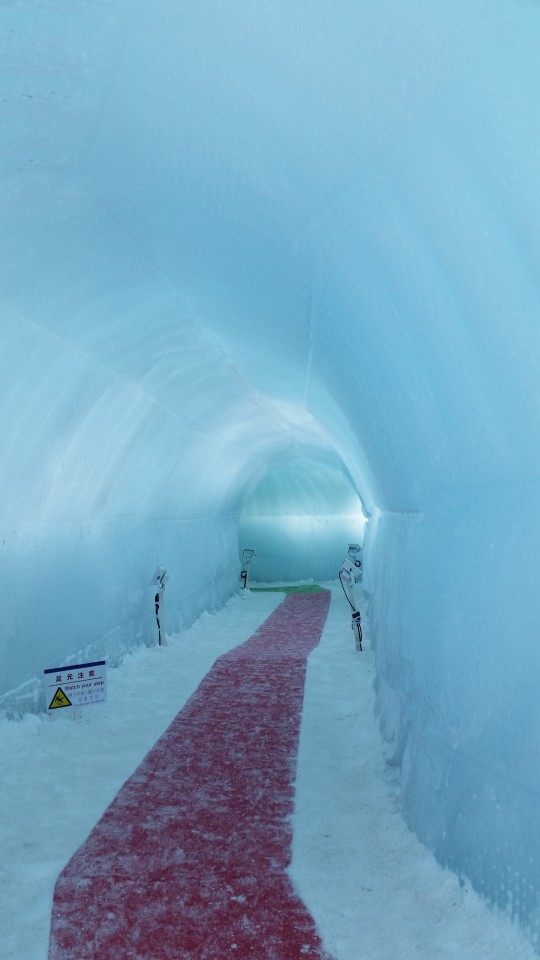
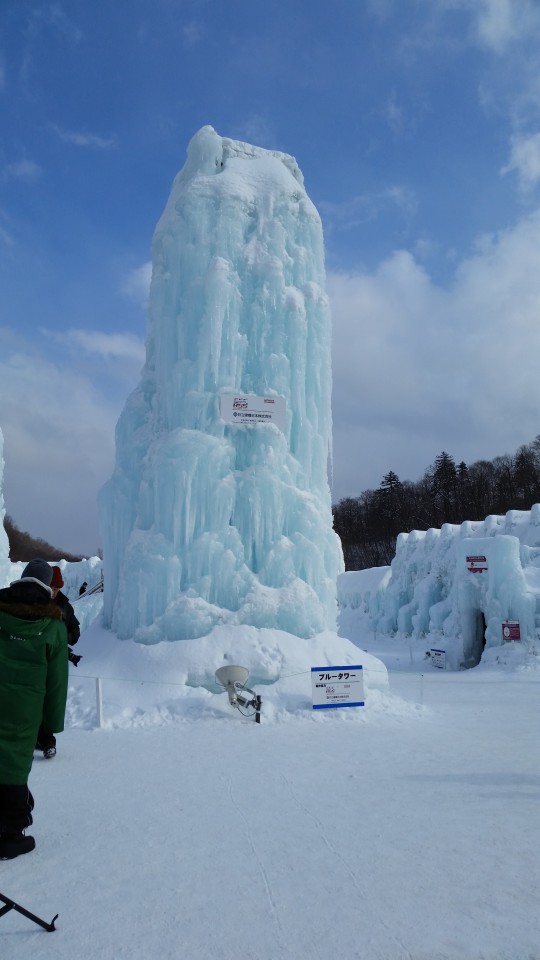
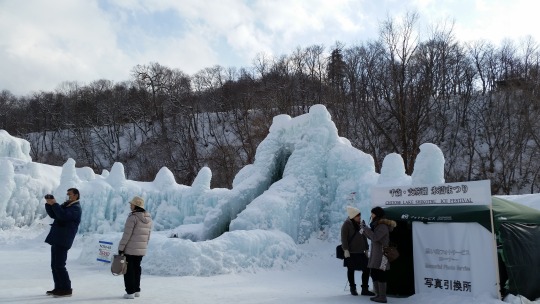
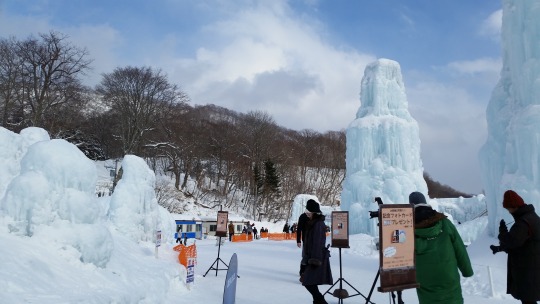
I didn't have a chance to explore the ice sculpture/caverns because we only had ten minutes at Lake Shikotsu, but I was able to get a few pictures before needing to run. Apparently there's a light show at night.
0 notes
Photo
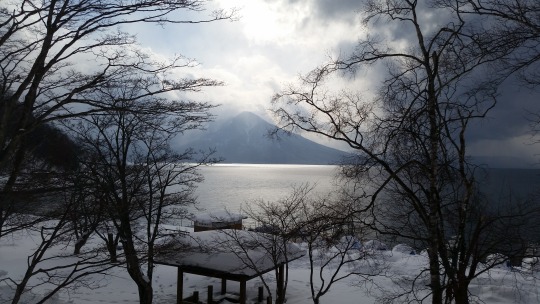
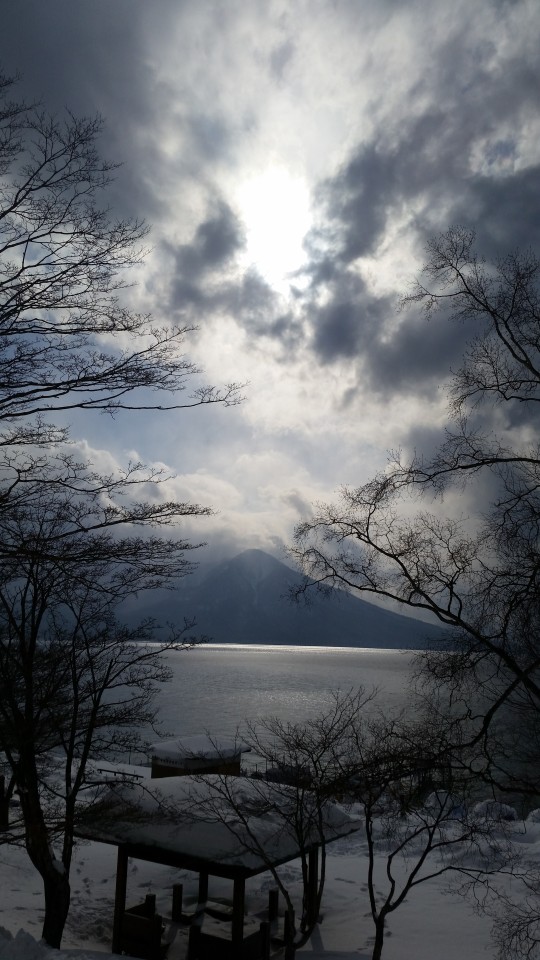

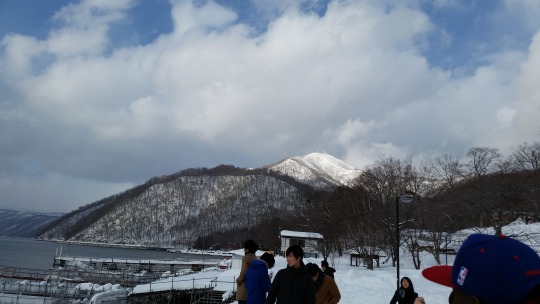
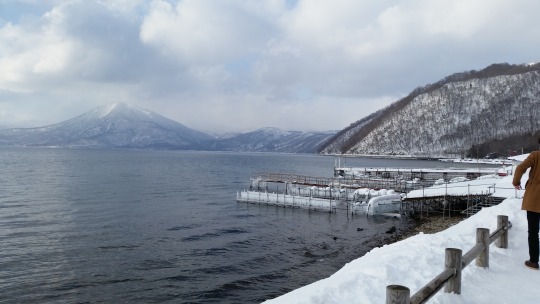
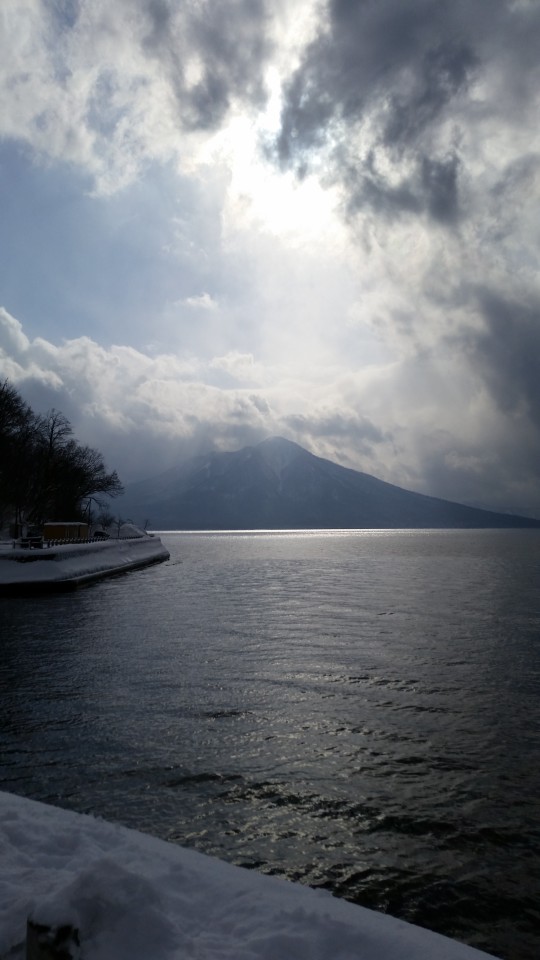

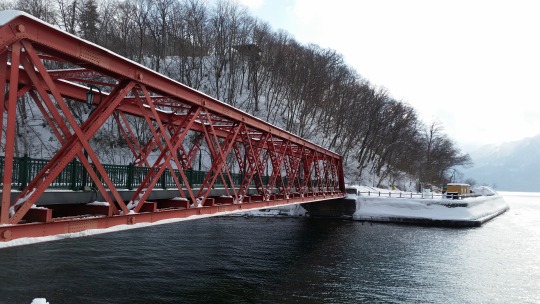
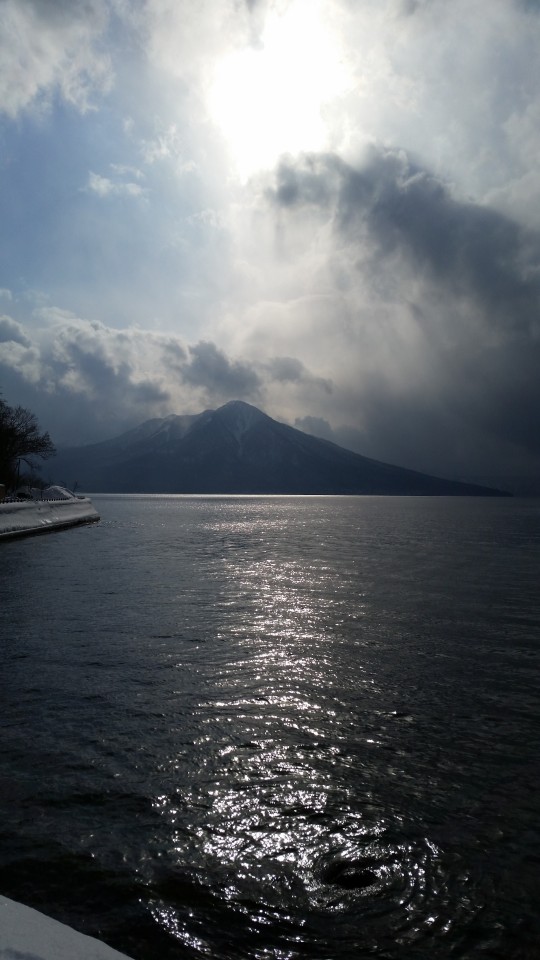
From my post on Lake Shikotsu:
The grey light of the sun spilled through the clouds and reflected on the lake like satin, and the mountains stood as dark grey guardians in the distance — slightly blurred by clouds as you might see in old Chinese and Japanese landscape paintings. The pure white snow cloaking everything just made the scene that much more like a winter fantasy and the bright red bridge popped out brilliantly in the near-monochrome and sepia world.
1 note
·
View note
Text
Hokkaido Trip Day 2 Part1: Lake Shikotsu
The second day we spent in Hokkaido, we started with breakfast at a curry soup restaurant. The curry soup was basically nabe for one person with a side of rice. The spiciness was something you determined in your order. It was a very filling breakfast/lunch -- with good reason as the next meal we would have would be dinner made in a cooking class
Due to a mishap of someone losing their wallet, we were delayed in leaving Sapporo and were only able to spend ten minutes at Lake Shikotsu before we needed to leave to arrive on time to the next place. It was only ten minutes, but the beauty of the scenery will stay ingrained in my memories for a long time. The grey light of the sun spilled through the clouds and reflected on the lake like satin, and the mountains stood as dark grey guardians in the distance -- slightly blurred by clouds as you might see in old Chinese and Japanese landscape paintings. The pure white snow cloaking everything just made the scene that much more like a winter fantasy and the bright red bridge popped out brilliantly in the near-monochrome and sepia world.
The bus ride there and back was also filled with snowy forests and rivers. The next place we would go to was the Hidaka Town Center where we would have a cooking class with locals.
0 notes
Text
Hokkaido Days 2 and 3
A brief preview/summary of the next days we spent there. There was so much, that I have to split pictures and explanations into pieces. I thought it would be nice to write my impressions in one short post first.
I saw and experienced many things in the time we spent in Hokkaido. The people of Hidaka were very warm and the days spent there will remain in my memories for a long time. The food we worked together to make in the cooking class was delicious, but I think my favorite moment was the after-dinner activities when we could interact with the children. Playing the gesture game (charades) with the kids and then seeing the wadaiko performance was both fun and exciting. These same kids who we cooked with earlier were performing something on stage that requires hours of hard work. It was an exciting performance and I could feel the joy and determination from all the members.
The next day, we saw the fishermen at work and enjoyed a wonderful lunch by the people at Ishisaki fisheries. It was my first time eating such fresh seafood and the atmosphere was so warm as we sat around the low tables with the cold winter blowing outside the little building. I created my first snowman and threw my first real snowball (the little ice-fragment ball four years ago in San Antonio doesn't count!) there. From there, spending the last moments in Tomikawa junior high school, I was touched by the lively students who were trying hard to communicate with me. We played Hokkaido style karuta -- the one where the first stanza is read and attacked instead of the first stanza being read and second stanza being memorized beforehand to attack-- and made little origami hina dolls. I know that the memories I made in my time here will be held dearly in my heart.
0 notes
Photo

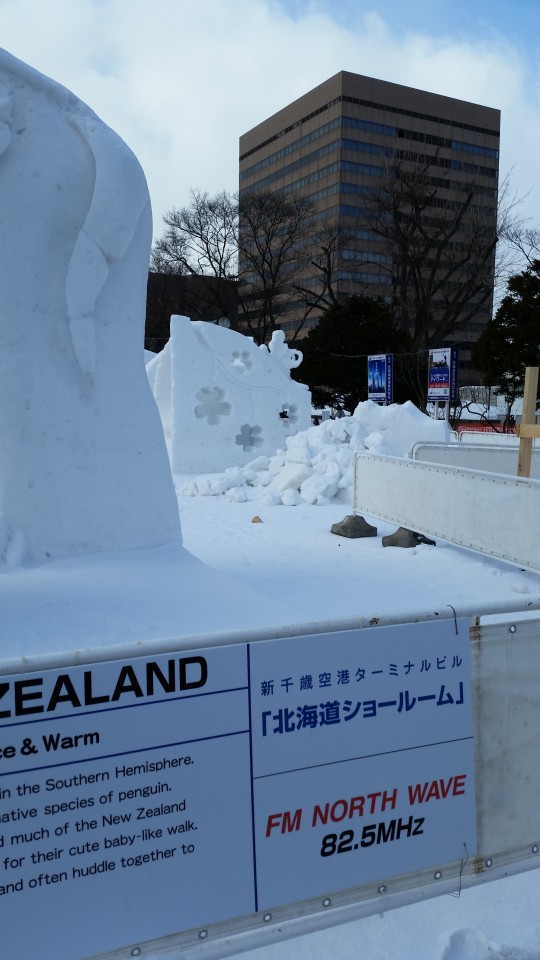

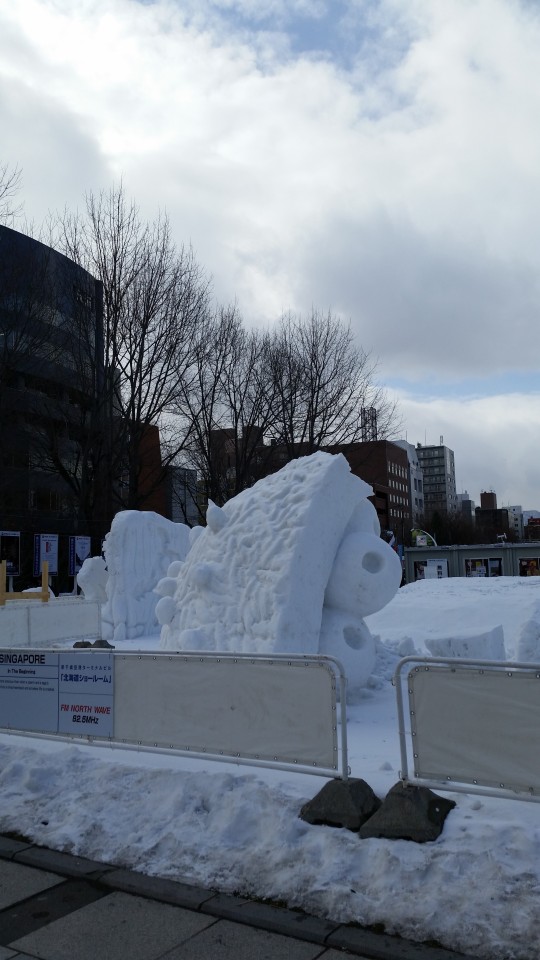

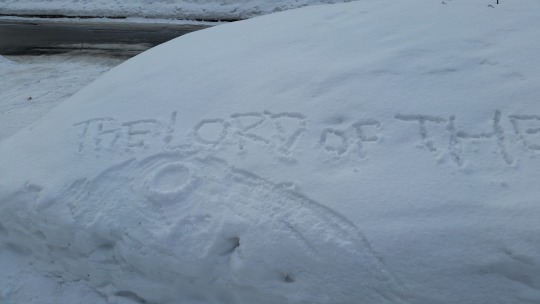
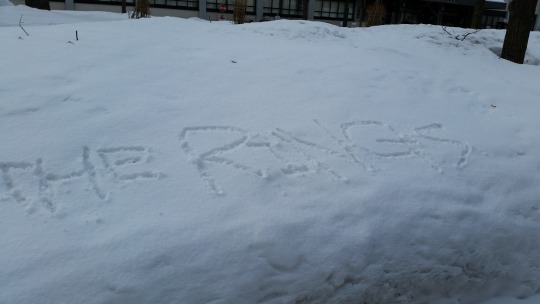

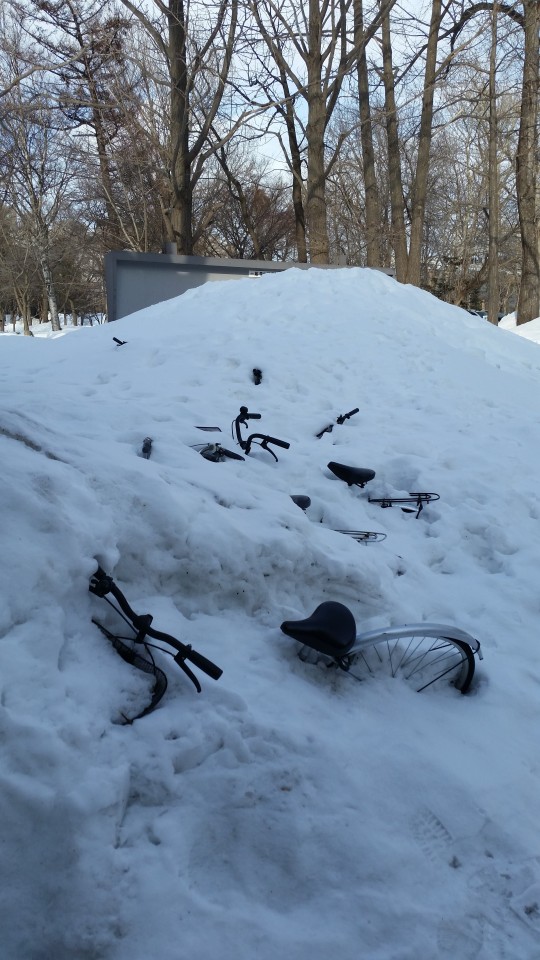
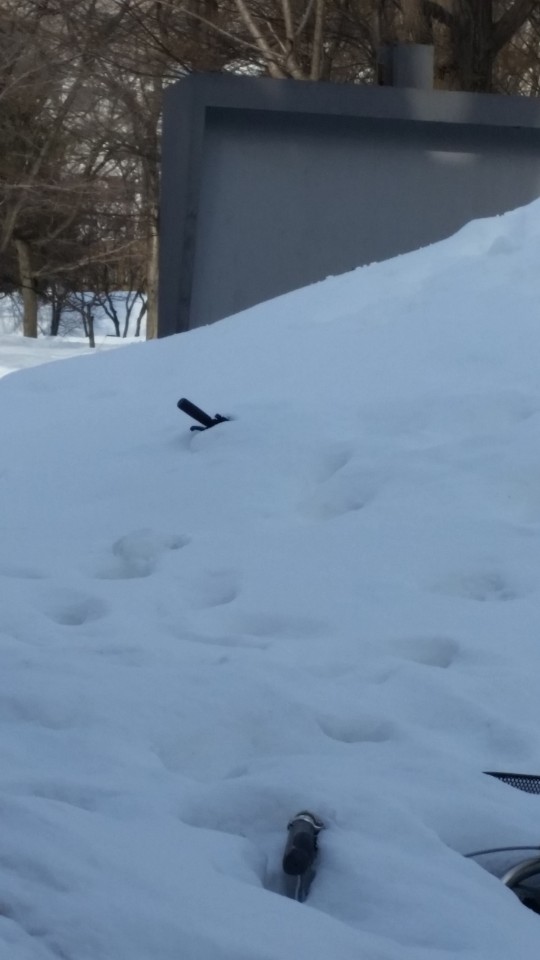
The last few pictures of the snow sculptures I took and then the first pictures of Hokkaido University. As I mentioned in this other post, we walked around the grounds and ate lunch there, followed by a nap in the library, and a bit more walking towards our next event.
Those bikes aren't stuck in just snow, by the way. Most of that is solid ice with only the top couple of centimeters (maybe a few inches at most) being snow.
0 notes
Photo
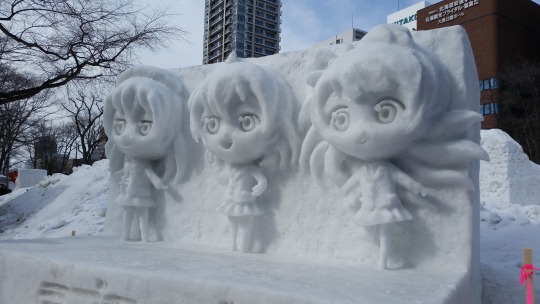


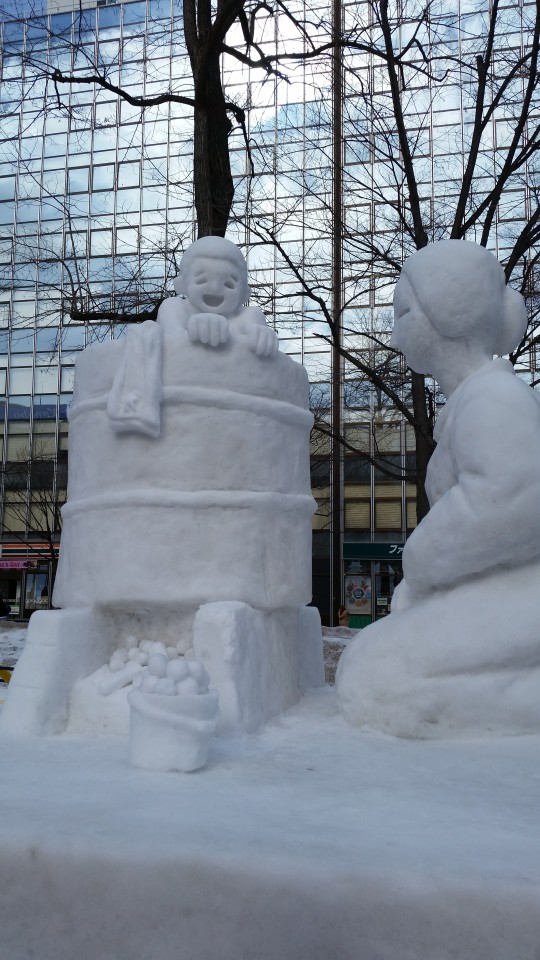
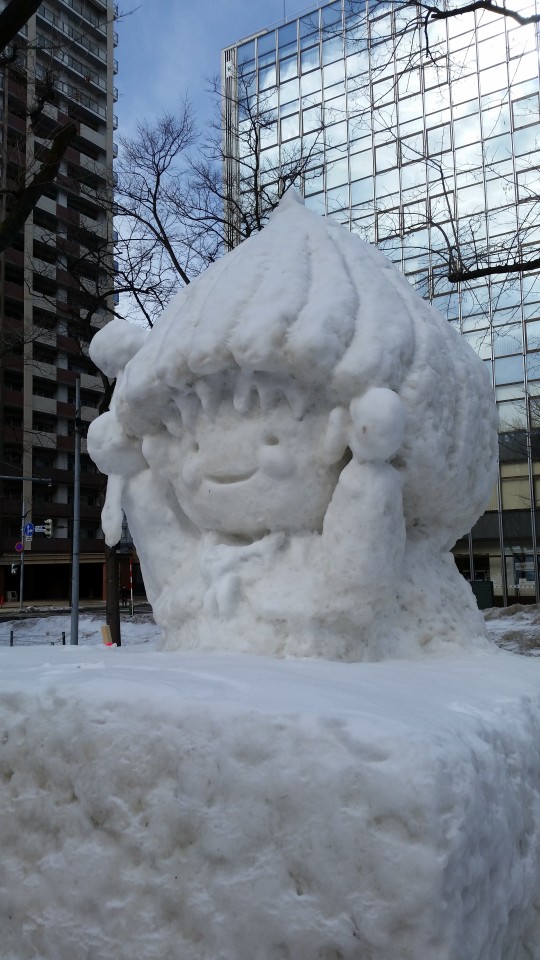
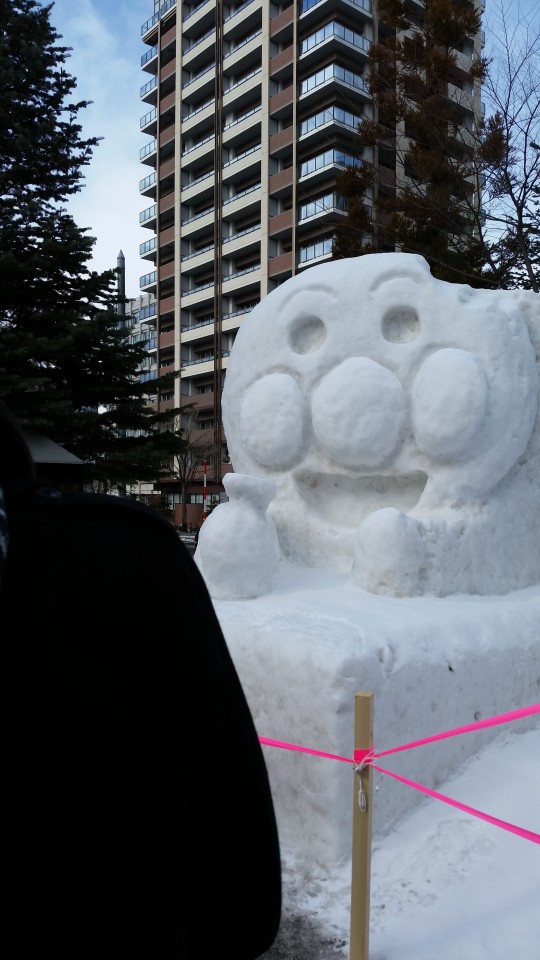
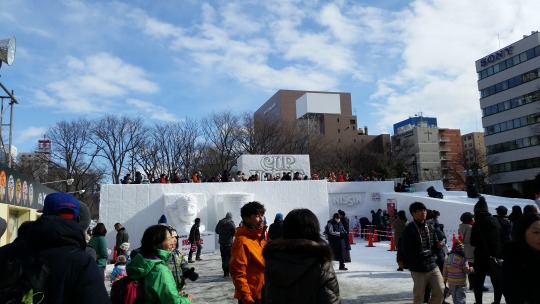
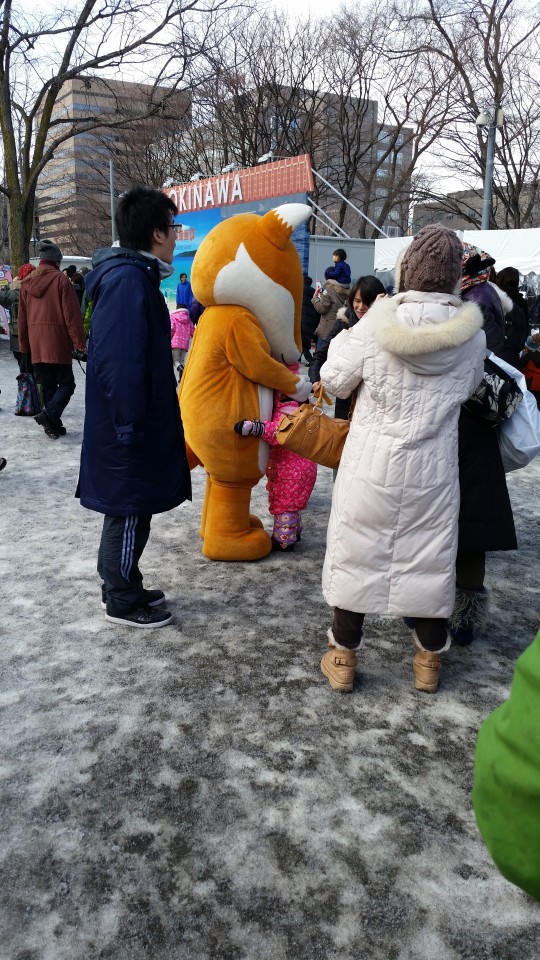
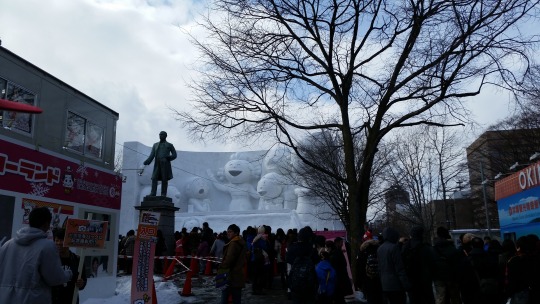
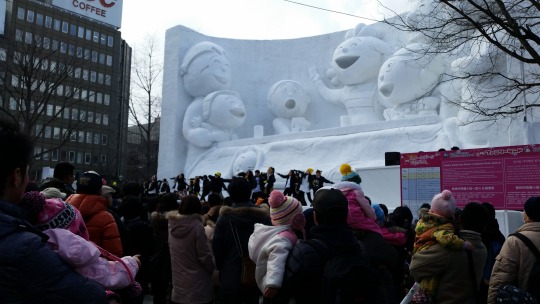
The second set of pictures from the Sapporo Snow festival/Yuki Matsuri. Youkai Watch, a sculpture of a woman bathing her kid the traditional manner, Anpanman (a popular Japanese cartoon character comparable to Doraemon), and a koropokkuru (tiny Ainu spirits that live under butterbur plants) make their appearance here. In the last pictures, you can see a statue of a pioneer of Sapporo named Horace Capron, and a dance performance on top of the snow sculpture stage behind him. There was also a Cup Noodles stage I took a picture of from a distance and a kitsune (fox) mascot going around giving hugs.
2 notes
·
View notes